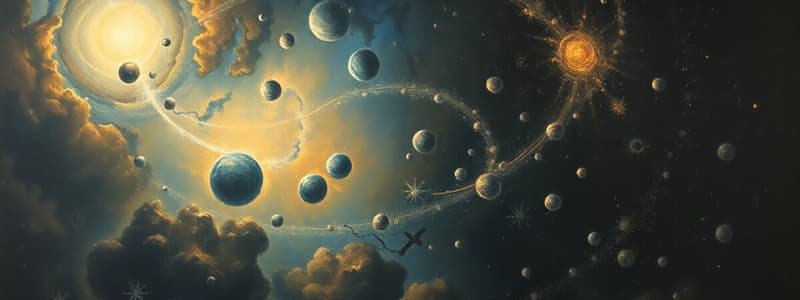Podcast
Questions and Answers
What comprises baryonic matter?
What comprises baryonic matter?
- Electromagnetic waves and photons
- Protons, electrons, and neutrons (correct)
- Dark matter and dark energy
- Gravitons and neutrinos
What percentage of the universe is made up of dark energy?
What percentage of the universe is made up of dark energy?
- 50%
- 24%
- 4.6%
- 71% (correct)
What is a protostar?
What is a protostar?
- The final stage of stellar evolution
- A fully developed star
- A star that has gone supernova
- An early stage in the formation of a star (correct)
Which of the following describes main sequence stars?
Which of the following describes main sequence stars?
What is the unit used to measure astronomical distance?
What is the unit used to measure astronomical distance?
What role does dark matter play in the formation of galaxies?
What role does dark matter play in the formation of galaxies?
How old is the universe estimated to be?
How old is the universe estimated to be?
What is a characteristic feature of massive main sequence stars?
What is a characteristic feature of massive main sequence stars?
What is the central theme of the Kuba people's creation narrative?
What is the central theme of the Kuba people's creation narrative?
What does the Steady State Model propose about the universe?
What does the Steady State Model propose about the universe?
Which cosmological model suggests the universe undergoes infinite cycles of expansion and contraction?
Which cosmological model suggests the universe undergoes infinite cycles of expansion and contraction?
Who formulated the Big Bang Theory?
Who formulated the Big Bang Theory?
What significant concept did Anaxagoras introduce about the primordial universe?
What significant concept did Anaxagoras introduce about the primordial universe?
Which model is characterized by the belief in a stationary Earth at the center of the universe?
Which model is characterized by the belief in a stationary Earth at the center of the universe?
What is a key feature of Einstein's model of the universe?
What is a key feature of Einstein's model of the universe?
In the cosmic narrative of India, what became of the sacrificed Purusha?
In the cosmic narrative of India, what became of the sacrificed Purusha?
Flashcards are hidden until you start studying
Study Notes
Baryonic Matter and Dark Matter
- Baryonic matter consists of protons, electrons, and neutrons, forming the building blocks of atoms, planets, stars, and galaxies.
- Dark matter has gravitational effects but does not emit light, explaining the cohesion of galaxies despite insufficient visible mass.
Dark Energy and Cosmic Expansion
- Dark energy acts as a source of anti-gravity, contributing to the universe's accelerated expansion.
- Comprising approximately 71% of the universe, dark energy influences cosmic dynamics alongside dark matter and baryonic matter.
Formation and Lifecycle of Stars
- Protostars form from the gravitational collapse of gas clouds, representing the initial phase of star development.
- Main Sequence Stars, such as the Sun, undergo thermonuclear reactions, fusing hydrogen into helium while maintaining equilibrium between nuclear fusion pressures and gravitational forces.
- Large stars consume hydrogen more rapidly than smaller stars, with our Sun expected to last around 10 billion years.
Structure of the Universe
- The universe is aged at least 13.8 billion years, while the Solar System is about 4.5-4.6 billion years old.
- Composed of 4.6% baryonic matter, 24% cold dark matter, and 71% dark energy, detailing its complex composition.
- Galaxies are massive clusters of stars, while superclusters represent collections of galaxies, with vast empty spaces in between.
Theories of the Universe's Origins
- Ancient mythologies offered various explanations for the universe's origin, involving creator deities and primordial elements.
- The Steady State Model, proposed in 1948, suggested continuous creation of matter to maintain density as the universe expands.
Primordial Universe Concept
- Philosopher Anaxagoras proposed that the universe began as a mix of elemental fragments, later structured through fundamental forces’ separation during expansion.
Cyclic Universe Theory
- The cyclic or oscillating universe model posits infinite cycles of Big Bang and cosmic contraction, resulting in a universe without a definitive beginning or end.
Historical Models of the Universe
- Ptolemaic Universe: Claudius Ptolemy's geocentric model featured Earth as a stationary center around which celestial bodies rotated in epicycles.
- Einsteinian Universe: Albert Einstein envisioned a static universe, neither expanding nor contracting, defying earlier dynamic models.
The Big Bang Theory
- Formulated by Abbe Georges Edouard Lemaitre, this prevailing theory explains the universe's origin as an expansion from a hot, dense state approximately 13.8 billion years ago.
Studying That Suits You
Use AI to generate personalized quizzes and flashcards to suit your learning preferences.

